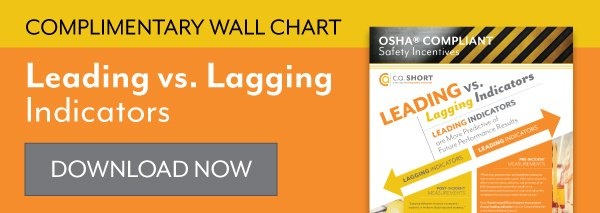
Implementing a culture of safety is key to prioritizing employee safety and wellbeing. Safety incentive programs reinforce safety protocols and encourage employees to work safely by rewarding them when they do. In order to build a successful safety incentive program, you must have a way to consistently measure success, as well as discover any areas of improvement.
Leading indicators are a great way to measure performance of your program by analyzing ways you can continuously improve. In this blog post we will discuss how to define leading indicators, while discussing how they can be effectively used in your incentive program.
Leading vs. Lagging Indicators
Leading and lagging indicators are two types of measurements used for assessing performance. A leading indicator is a predictive measurement, while a lagging indicator is an output measurement. When used in your incentive program, a leading indicator can be used to influence change, while a lagging indicator can only record what has happened.
An example of this would be the percentage of people wearing hard hats on a building site compared to the total number of accidents. The leading indicator: the percentage of hard hats being used can be changed throughout the program which can then affect the lagging indicator.
By focusing on the leading indicators above the lagging indicator, you can influence positive change within your organization, leading to fewer accidents and lower costs.
Defining Leading Indicators
According to a study conducted by the Campbell Institute, leading indicators measure the events leading up to injuries and fatalities, and also provide information about the current state of an organization’s safety management system. Leading indicators are designed to give advanced warning of potential problems so that preventive actions can be taken. Additionally, they help to reveal weaknesses in an organization’s procedures or employee behavior before they have a chance to cause real harm.
The study is recognized by The National Safety Council and OSHA and defines leading indicators based on a matrix that sorts the indicators into 3 categories.
- Operations-based: Indicators that are relevant to the functioning of an organization’s infrastructure (e.g. machinery, operations); potentially site-specific.
- Systems-based: Indicators that relate more to the management of an EHS system; can be rolled up from a facility level to a region/business unit or corporate level.
- Behavior-based: Indicators that measure the behavior or actions of individuals or groups in the workplace; people-to-people interactions related to supervision and management; useful at site-specific level through management level.
Examples of Leading Indicator Metrics
The study by the Campbell Institute, provides a full list of leading indicator metrics that are categorized by the three categories listed above, as well as the leading indicator itself. We’ve provided a few of these examples below.
Risk Assessment:
- Percent of assessments completed per plan
- Ratio between the levels of risk identified (high, medium, low)
- Scoring the steps of an operation on severity, exposure, and probability
- Number of assessments communicated
Hazard Identification/Recognition:
- Number of near miss reports
- Number of unsafe observations (conditions or behaviors)
- Number of safe observations (conditions or behaviors)
- Number of unsafe observations per inspection
Preventive & Corrective Actions:
- Number of corrective actions for critical issues validated for effectiveness by managers
- Number and percent of issues in conformance with recommended corrective actions
- Percent or ratio of corrective actions at each level of control (according to hierarchy of controls)
- Percent or ratio of corrective actions according to hazard type (e.g. confined space, fall protection, etc.)
Communication of Safety:
- Number of users of EHS dashboard
- Number and frequency of employee meetings
- Number of tailgates/pre-shift safety talks completed
- Number of bulletin boards with current/relevant information
C.A. Short’s Safety Incentive Program
For over 75 years, C.A. Short Company has been helping companies create effective safety incentive programs, catered to their organizational needs. Our OSHA-compliant safety incentive program, Safegagement™ helps you identify the leading indicators essential to your business, as well as easily monitor performance for real results. To learn more about our Safegagement platform or the components of Safegagement, download our complimentary white paper, Safegagement: Creating Safe Companies that Thrive.







.jpg)


.png)
SHARE